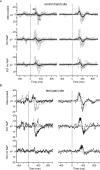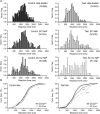Multimodal sensory evaluation of neuropathic spinal cord injury pain: an experimental study
- PMID: 33446934
- PMCID: PMC8338558
- DOI: 10.1038/s41393-020-00607-z
Multimodal sensory evaluation of neuropathic spinal cord injury pain: an experimental study
Abstract
Study design: An experimental study.
Objectives: To investigate the changes in somatosensory functions using the combined application of quantitative sensory testing (QST), contact heat-evoked potentials (CHEPs) and laser-evoked potentials (LEPs) studies in individuals with spinal cord injury (SCI) in relation to neuropathic pain (NeP).
Setting: Centre for Pain Medicine, Swiss Paraplegic Centre, Nottwil, Switzerland.
Methods: Individuals with SCI were compared: 12 with NeP (SCI NeP) and 12 without NeP (SCI no NeP). Tools used were QST, CHEPs, LEPs and self-reported questionnaires. Tests were applied to the control (hand) and test (dermatome of altered sensation) sites, and compared to the able-bodied group.
Results: QST, LEPs and CHEPs assessments showed abnormalities both on the test and control sites, which did not differ between the groups with SCI. QST showed higher prevalence of allodynia in SCI NeP. CHEPs and LEPs demonstrated diminished amplitudes in both groups with SCI in comparison to able-bodied individuals. Only reaction time (RT) analysis revealed the difference of SCI NeP from the other two groups, expressed in partially preserved responses to the laser C-fibre stimulations.
Conclusions: Combination of assessments in our study allowed to examine spinothalamic and dorsal column functions in individuals with SCI. Changes in QST, CHEPs and LEPs were detected below the level of injury independent of NeP and at the control site indicating modifications in sensory processing rostral to the spinal lesion. Analysis of RT during laser stimulation could be an essential component when evaluating the somatosensory functions related to NeP in persons with SCI.
© 2021. The Author(s).
Conflict of interest statement
The authors declare that they have no conflict of interest.
Figures



Similar articles
-
Usefulness of laser-evoked potentials and quantitative sensory testing in the diagnosis of neuropathic spinal cord injury pain: a multiple case study.Spinal Cord. 2017 Jun;55(6):575-582. doi: 10.1038/sc.2016.191. Epub 2017 Jan 24. Spinal Cord. 2017. PMID: 28117333
-
Identifying Discomplete Spinal Lesions: New Evidence from Pain-Autonomic Interaction in Spinal Cord Injury.J Neurotrauma. 2021 Dec;38(24):3456-3466. doi: 10.1089/neu.2021.0280. J Neurotrauma. 2021. PMID: 34806429
-
The effects of transcranial direct current stimulation with visual illusion in neuropathic pain due to spinal cord injury: an evoked potentials and quantitative thermal testing study.Eur J Pain. 2013 Jan;17(1):55-66. doi: 10.1002/j.1532-2149.2012.00167.x. Epub 2012 May 18. Eur J Pain. 2013. PMID: 22610590 Clinical Trial.
-
The involvement and significance of M2 macrophages in neuropathic pain following spinal cord injury: a systematic review.J Physiol Sci. 2024 Sep 18;74(1):45. doi: 10.1186/s12576-024-00932-5. J Physiol Sci. 2024. PMID: 39294621 Free PMC article.
-
Electrophysiology in diagnosis and management of neuropathic pain.Rev Neurol (Paris). 2019 Jan-Feb;175(1-2):26-37. doi: 10.1016/j.neurol.2018.09.015. Epub 2018 Oct 26. Rev Neurol (Paris). 2019. PMID: 30482566 Review.
Cited by
-
The Role of Maladaptive Plasticity in Modulating Pain Pressure Threshold Post-Spinal Cord Injury.Healthcare (Basel). 2025 Jan 26;13(3):247. doi: 10.3390/healthcare13030247. Healthcare (Basel). 2025. PMID: 39942436 Free PMC article.
-
Variability in clinical and neurophysiological evaluation of pain development following acute spinal cord injury: a case report.Spinal Cord Ser Cases. 2021 Aug 7;7(1):72. doi: 10.1038/s41394-021-00435-0. Spinal Cord Ser Cases. 2021. PMID: 34365469 Free PMC article.
-
Assessing the Feasibility of a Multimodal Approach to Pain Evaluation in Early Stages after Spinal Cord Injury.Int J Mol Sci. 2023 Jul 5;24(13):11122. doi: 10.3390/ijms241311122. Int J Mol Sci. 2023. PMID: 37446303 Free PMC article.
References
MeSH terms
LinkOut - more resources
Full Text Sources
Other Literature Sources
Medical

